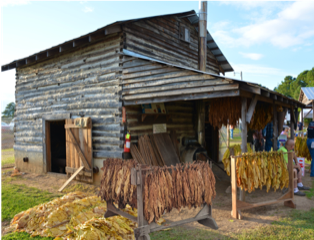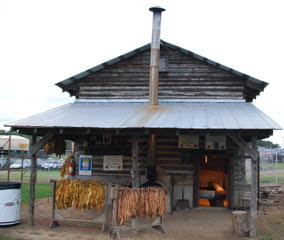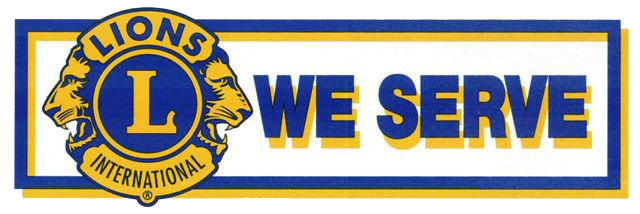History at the Fair
Written by Zack Taylor. Updated by Pam Kerley.
The Lee Regional Fair is known to be a strong supporter of agriculture, but did you know history can also be relived there through our tobacco heritage? When driving through Lee County, you will notice tobacco is big business here, and it also has a long history.
Tobacco was first discovered in the New World and taken back to Europe by Sir Walter Raleigh. North Carolina was the place to grow tobacco even at that time, and it was even exported several decades before the Revolutionary War. Once advances were made in cigarette manufacturing in the 1880s, tobacco became North Carolina's largest source of income. Separated into 5 tobacco-growing regions called belts, Lee County is well centered in what is known as the middle belt. Today, North Carolina continues to be #1 in the nation in tobacco production, adding over 7 billion dollars to our state’s economy.
While the entire process of tobacco production is labor intensive, the curing is one part that many will remember best. Widely considered a science and an art form, the curing process would begin by tying tobacco leaves to sticks, which were about 1 inch square and about 6 feet long. The women on the farm often worked this task while the men continued to harvest the tobacco during the heat of the day.
At the end of the day, the men would return from the field and “load” into the barn the sticks with tobacco tied on them. The sticks were 6 feet long due to the spacing between the rafters in the barn, which allowed the tobacco to freely hang. The “art” of curing then began. The fire would be lit in the exterior furnace at the barn, using wood as a heat source. From the furnace, a network of flues, much like the ductwork in your home, just above the floor of the barn, would distribute the heat throughout the barn before eventually exiting the chimney. This is where the term flue-cured tobacco comes from, and it is the most common type of tobacco grown in North Carolina.

In order to get the proper cure and leaf color, the fire had to be monitored closely, slowly raising the temperature in the barn over the course of about a week. Too fast and the leaves would be brittle; too slow and the leaves would be too wet. A skilled farmer would know just the right time to add wood to the fire to bring up the barn temperature. This system resulted in a distinct tobacco flavor, which is high in sugar and highly sought after. It also resulted in the brightly colored leaves of tobacco our state is known for, and is often referred to as bright leaf tobacco.
Once the tobacco was cured, leaves would be tied into small bundles called hands, to display their color and quality in an attempt to bring the best price at the auction. Today, this process has been replaced by modern barns that contain large boxes of compressed tobacco and have gas burners that can be controlled much more precisely (often by smartphones), to save time and labor. Once cured, the tobacco is compressed into a large bale weighing over 750 pounds and then trucked to the market.
While the process of curing in wooden barns has become extinct, it can still be viewed at the Lee Regional Fair. Just like the many tobacco barns that once dotted the landscape across our county and state, the Lee Regional Fair showcases an original tobacco barn used in Lee County for many years.

Saved from demolition and moved to the fairgrounds to preserve and showcase our heritage, the barn is fully functional and used once a year during the Fair. Operated by the Central Carolina Power and Equipment (C-CAPE) club, Fairgoers have the opportunity to see the process of flue curing and can even have a hand in “loading the barn.” While you're enjoying the Fair, don't forget to stop by the barn during the week, to check on the curing process of the tobacco you helped “put in."
 Sanford Lions Club
Sanford Lions Club
sponsors the annual
Lee Regional Fair.
www.SanfordLionsClub.com
